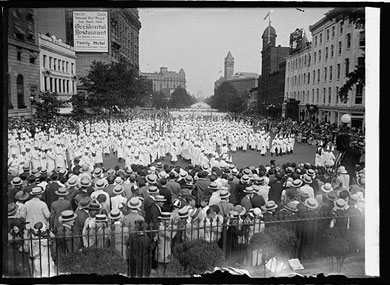![]() This document is a copy of the 19th Amendment. Read the text of the amendment. What does it mean? Click on the image.
This document is a copy of the 19th Amendment. Read the text of the amendment. What does it mean? Click on the image.


Source: A flapper girl, Library of Congress
One of the most drastic changes of the 1920s was of the role of women in American society. Many considered the women of Roaring Twenties as the “New Woman.” Many of the middle-class women of this period changed the way that they dressed. Many, like the one pictured above, were called flappers, women who dressed fashionably, some with short skirts and dresses, visible makeup, and a new attitude of freedom.
The role of the middle class woman changed from the traditional role as housewives who only worked within the home to woman who worked and embarked on new adventures. Women began to work outside the home, many of them had worked during World War I and others worked for the first time. Many women were employed as secretaries, waitresses, or in small businesses such as cleaners. Poverty, however, still existed for African Americans, poor whites, and many immigrants.
![]() Watch this video about the Roaring Twenties.
Watch this video about the Roaring Twenties.
Source: Flappers of the 1920's, dwenig2010, YouTube

Source: Life magazine, February 18, 1926, showing a well dressed old man dancing with a flapper, john Held, Library of Congress
The Roaring Twenties is sometimes referred to as the Jazz Age. This term refers to the cultural movement of the 1920s involving an explosion of new music, dancing, and entertainment. Jazz music became popular and musicians such as Luis Armstrong and Duke Ellington became popular. New dances such as the Charleston, pictured on the magazine cover above, were also popular.
Some changes of the Roaring Twenties caused unrest in America. While there were some social and cultural advancements made, traditional societal ills also advanced. Race relations in the United States started to decline during this period.
There was a resurgence in the Ku Klux Klan. The Klan, also known as the KKK, was an organization that began during the era of Reconstruction. One of the main functions of the KKK was to promote racism and instill fear in the newly freed slaves. By the 1920s, the group had grown to 3 million members that included anti-Semitism and anti-Catholicism.

Source: KKK Parade, 8/8/25, Library of Congress
On August 8, 1925, the Ku Klux Klan attracted national attention when 40,000 of its members paraded down Pennsylvania Avenue in Washington D.C.
The KKK’s march in Washington D.C. was indicative of the attitudes of many white Americans when it came to race during the 1920s. The KKK was responsible for violently terrifying blacks in the South, and eventually influencing violent acts across the country.
The idea of nativism permeated the country, leading to race riots and violent behavior in many parts of the United States. Although most African Americans were politically powerless to fight back, there were some who found a way to respond to the violent behavior.

Source: Marcus Garvey, 1887-1940, Library of Congress
Marcus Garvey founded the Universal Negro Improvement Association (UNIA), an organization that focused on uniting all people of African descent to create a country with its own government.
Click on the link below to learn more about Marcus Garvey.
The technological advances of the 1920s yielded some of the most talented minds that led to technological innovations. The Roaring Twenties inspired people to become daring and do things that had never been done before. The two individuals below exhibited examples of such courage and ingenuity.
Click on each image to learn more.
In the next section, you will examine the impact of political issues during the Roaring Twenties.
Sources for images used in this section, as they appear, top to bottom: